Part Functionality Alterations Induced by Changes of Surface Integrity in Metal Milling Process: A Review
Abstract
1. Introduction
2. Part Functionality as Effected by Surface Topography
2.1. Machined Surface Topography Characteristic
2.2. Fatigue Strength and Wear Resistance as Effected by Surface Topography
3. Part Functionality as Effected by Surface Metallurgy
3.1. Machined Surface Metallurgy Characteristic
3.2. Wear Resistance and Corrosion Resistance as Effected by Surface Metallurgy
4. Part Functionality as Effected by Surface Residual Stress
4.1. Residual Stress Characteristic on Machined Surface
4.2. Fatigue Resistance as Effected by Surface Residual Stress
5. Conclusions and Outlook
- The effects of surface integrity on performance were mostly determined by experiments and could not be revealed effectively at the mechanism level.
- No uniform standard has been formed to assess the effect of surface integrity parameters on fatigue performance, which limits the optimization of process parameters and the improvement of service performance of workpieces.
- The local performance change, design, and service performance state of the parts could not be organically combined to form an interconnected mode.
- Combined with the current research status and engineering application requirements, the following aspects can be emphatically studied in the future.
- To strengthen theoretical research on fatigue performance optimization. The existing optimization models assume that the surface integrity evaluation indices (surface morphology, residual stress, microhardness, and metamorphic layer thickness) have the same effect on fatigue performance, so the weight of the coefficient of the optimization model is consistent. In order to make the optimization result more accurate, the corresponding mathematical analysis method can be considered to distinguish the weight of various indexes.
- To strengthen the research on modeling technology of machined surface integrity and workpiece performance. The analytic model of residual stress of workpiece surface during milling is still a difficult problem. The reason is that the change of chip thickness on cutting edge is more complicated, which results in the nonlinear gradient distribution of cutting force and cutting temperature in machining process. Only some physical factors (vibration, tool/workpiece deformation, and cutting force) are considered in the analytical model of surface topography, while tool wear and the characteristics of interrupted cutting are not taken into account, so there is still a large error in the simulation results.
- Development of new milling processes. The reasonable selection of process parameters directly affects the machined surface integrity and controls the workpiece performance. How to develop a new milling process based on different machining systems, processing environment, workpiece materials, and performance needs to be further explored.
- The relationship between the design-manufacturing-service performance of parts is explored. A complete interconnected mode of design, manufacturing, and service performance evaluation of parts was established.
- The theoretical analysis and experimental research on the response relationship between high temperature fatigue, vibration fatigue, corrosion fatigue performance, and surface integrity of processing under environmental conditions are further improved.
Author Contributions
Funding
Conflicts of Interest
References
- Field, M.; Kahles, J.F.; Cammett, J. Review of measuring methods for surface integrity. CIRP 1972, 21, 219–238. [Google Scholar]
- Field, M.; Kahles, J.F. Review of Surface Integrity of Machined Components; Defense Technical Information Center: Fort Belvoir, VA, USA, 1971. [Google Scholar]
- Field, M.; Kahles, J. The surface integrity of machined-and ground high-strength steels. DIMC Rep. 1946, 210, 54–58. [Google Scholar]
- Yue, C.; Liu, X.; Ma, J.; Liu, Z. Hardening effect on machined surface for precise hard cutting process with consideration of tool wear. Chin. J. Mech. Eng. 2014, 27, 1249–1256. [Google Scholar] [CrossRef]
- Yue, C.; Liu, X. Research progress of machined surface integrity for high stress steel cutting process. J. Harbin Univ. Sci. Technol. 2012, 16, 5–10. [Google Scholar]
- Jawahir, I.; Brinksmeier, E.; M’saoubi, R.; Aspinwall, D.; Outeiro, J.; Meyer, D.; Umbrello, D.; Jayal, A. Surface integrity in material removal processes: Recent advances. CIRP Ann. Manuf. Technol. 2011, 60, 603–626. [Google Scholar] [CrossRef]
- Ulutan, D.; Ozel, T. Machining induced surface integrity in titanium and nickel alloys: A review. Int. J. Mach. Tool Manuf. 2011, 51, 250–280. [Google Scholar] [CrossRef]
- Davim, J.P. Surface Integrity in Machining; Springer: Berlin, Germany, 2010. [Google Scholar]
- Klocke, F.; Brinksmeier, E.; Weinert, K. Capability profile of hard cutting and grinding processes. CIRP Ann. Manuf. Technol. 2005, 54, 22–45. [Google Scholar] [CrossRef]
- M’Saoubi, R.; Outeiro, J.; Chandrasekaran, H.; Dillon, O.; Jawahir, I. A review of surface integrity in machining and its impact on functional performance and life of machined products. Int. J. Sustain. Manuf. 2008, 1, 203–236. [Google Scholar] [CrossRef]
- Aris, N.; Cheng, K. Characterization of the surface functionality on precision machined engineering surfaces. Int. J. Adv. Manuf. Technol. 2008, 38, 402–409. [Google Scholar] [CrossRef]
- Budak, E. Analytical models for high performance milling. Part I: Cutting forces, structural deformations and tolerance integrity. Int. J. Mach. Tool Manuf. 2006, 46, 1478–1488. [Google Scholar] [CrossRef]
- Zhang, S.; Guo, Y. Taguchi method based process space for optimal surface topography by finish hard milling. J. Manuf. Sci. Eng. ASME 2009, 131, 051003. [Google Scholar] [CrossRef]
- Wang, Z.; Yuan, J.; Yin, Z.; Hu, X. Surface topography and roughness of high-speed milled AlMn1Cu. Chin. J. Mech. Eng. 2016, 29, 1200–1207. [Google Scholar] [CrossRef]
- Ghani, J.A.; Choudhury, I.; Hassan, H. Application of Taguchi method in the optimization of end milling parameters. J. Mater. Process. Technol. 2004, 145, 84–92. [Google Scholar] [CrossRef]
- Li, Z.L.; Zhu, L.M. Envelope surface modeling and tool path optimization for five-axis flank milling considering cutter runout. J. Manuf. Sci. Eng. ASME 2014, 136, 041021. [Google Scholar] [CrossRef]
- Denkena, B.; Böß, V.; Nespor, D.; Gilge, P.; Hohenstein, S.; Seume, J. Prediction of the 3D Surface Topography after Ball End Milling and its Influence on Aerodynamics. Procedia CIRP 2015, 31, 221–227. [Google Scholar] [CrossRef]
- Zhang, C.; Guo, S.; Zhang, H.; Zhou, L. Modeling and predicting for surface topography considering tool wear in milling process. Int. J. Adv. Manuf. Technol. 2013, 68, 2849–2860. [Google Scholar] [CrossRef]
- Irene, B.C.; Joan, V.C.; Alejandro, D.F. Surface topography in ball-end milling processes as a function of feed per tooth and radial depth of cut. Int. J. Mach. Tool Manuf. 2012, 53, 151–159. [Google Scholar]
- Gao, Y.; Sun, R.; Chen, Y.; Leopold, J. Analysis of chip morphology and surface topography in modulation assisted machining. Int. J. Mech. Sci. 2016, 111, 88–100. [Google Scholar] [CrossRef]
- Arizmendi, M.; Campa, F.J.; Fernández, J.; Gil, A.; Bilbao, E.; Veiga, F.; Lamikiz, A. Model for surface topography prediction in peripheral milling considering tool vibration. CIRP Ann. Manuf. Technol. 2009, 58, 93–96. [Google Scholar] [CrossRef]
- Lazoglu, I. 3D surface topography analysis in 5-axis ball-end milling. CIRP Ann. Manuf. Technol. 2017, 66, 133–136. [Google Scholar]
- Zhang, W.H.; Tan, G.; Wan, M.; Gao, T. A new algorithm for the numerical simulation of machined surface topography in multiaxis ball-end milling. J. Manuf. Sci. Eng. ASME 2008, 130, 284. [Google Scholar] [CrossRef]
- Gao, T.; Zhang, W.; Qiu, K.; Wan, M. Numerical simulation of machined surface topography and roughness in milling process. J. Manuf. Sci. Eng. ASME 2006, 128, 96–103. [Google Scholar] [CrossRef]
- Tan, L.; Yao, C.; Ren, J.; Zhang, D. Effect of cutter path orientations on cutting forces, tool wear, and surface integrity when ball end milling TC17. Int. J. Adv. Manuf. Technol. 2016, 88, 1–14. [Google Scholar] [CrossRef]
- Chen, X.; Zhao, J.; Dong, Y.; Li, A.; Wang, D. Research on the machined surface integrity under combination of various inclination angles in multi-axis ball end milling. Proc. Inst. Mech. Eng. B J. Eng. 2014, 228, 31–50. [Google Scholar] [CrossRef]
- Lu, X.; Hu, X.; Jia, Z.; Liu, M.; Gao, S.; Qu, C. Model for the prediction of 3D surface topography and surface roughness in micro-milling Inconel 718. Int. J. Adv. Manuf. Technol. 2017, 94, 2043–2056. [Google Scholar] [CrossRef]
- Brito, T.G.; Paiva, A.P.; Ferreira, J.R.; Balestrassi, P. A normal boundary intersection approach to multiresponse robust optimization of the surface roughness in end milling process with combined arrays. Precis. Eng. 2014, 38, 628–638. [Google Scholar] [CrossRef]
- Tangjitsitcharoen, S.; Thesniyom, P.; Ratanakuakangwan, S. Prediction of surface roughness in ball-end milling process by utilizing dynamic cutting force ratio. J. Intell. Manuf. 2017, 28, 13–21. [Google Scholar] [CrossRef]
- Benardos, P.; Vosniakos, G.-C. Predicting surface roughness in machining: A review. Int. J. Mach. Tool Manuf. 2003, 43, 833–844. [Google Scholar] [CrossRef]
- Benardos, P.; Vosniakos, G.C. Prediction of surface roughness in CNC face milling using neural networks and Taguchi’s design of experiments. Robot. Comput. Integr. Manuf. 2002, 18, 343–354. [Google Scholar] [CrossRef]
- Toh, C.K. Surface topography analysis in high speed finish milling inclined hardened steel. Precis. Eng. 2004, 28, 386–398. [Google Scholar] [CrossRef]
- Ginting, A.; Nouari, M. Surface integrity of dry machined titanium alloys. Int. J. Mach. Tool Manuf. 2009, 49, 325–332. [Google Scholar] [CrossRef]
- Yang, H.; Chen, Z.; Zhou, Z. Influence of cutting speed and tool wear on the surface integrity of the titanium alloy Ti-1023 during milling. Int. J. Adv. Manuf. Technol. 2015, 78, 1113–1126. [Google Scholar]
- Du, J.; Liu, Z.; Lv, S. Deformation-phase transformation coupling mechanism of white layer formation in high speed machining of FGH95 Ni-based superalloy. Appl. Surf. Sci. 2014, 292, 197–203. [Google Scholar] [CrossRef]
- Xue, C.; Chen, W.Y. Surface damages generated in hole making of a cast nickel-based alloy. Mater. Sci. Forum 2012, 697, 57–60. [Google Scholar]
- Blotter, L.K.G.P.T. The formation and properties of machining burrs. J. Eng. Ind. 1976, 98, 66–74. [Google Scholar]
- Novovic, D.; Dewes, R.; Aspinwall, D.; Voice, W.; Bowen, P. The effect of machined topography and integrity on fatigue life. Int. J. Mach. Tool Manuf. 2004, 44, 125–134. [Google Scholar] [CrossRef]
- Chrzanowski, W.; Neel, E.A.A.; Armitage, D.A.; Knowles, J. Effect of surface treatment on the bioactivity of nickel–titanium. Acta Biomater. 2008, 4, 1969–1984. [Google Scholar] [CrossRef] [PubMed]
- Arola, D.; Williams, C.L. Estimating the fatigue stress concentration factor of machined surfaces. Int. J. Fatigue 2002, 24, 923–930. [Google Scholar] [CrossRef]
- Moussaoui, K.; Mousseigne, M.; Senatore, J.; Chieragatti, R. The effect of roughness and residual stresses on fatigue life time of an alloy of titanium. Int. J. Adv. Manuf. Technol. 2015, 78, 557–563. [Google Scholar] [CrossRef]
- Li, W.; Guo, Y.; Guo, C. Superior surface integrity by sustainable dry hard milling and impact on fatigue. CIRP Ann. Manuf. Technol. 2013, 62, 567–570. [Google Scholar] [CrossRef]
- Li, X.; Zhao, P.; Niu, Y.; Guan, C. Influence of finish milling parameters on machined surface integrity and fatigue behavior of Ti1023 workpiece. Int. J. Adv. Manuf. Technol. 2017, 91, 1297–1307. [Google Scholar] [CrossRef]
- Wang, X.; Huang, C.; Zou, B.; Liu, G.; Zhu, H. Experimental study of surface integrity and fatigue life in the face milling of inconel 718. Front. Mech. Eng. 2018, 13, 243–250. [Google Scholar] [CrossRef]
- Noll, G.C.; Erickson, G.C. Allowable stresses for steel members of finite life. Proc. Soc. Experts Stress Anal. 1948, 5, 132–143. [Google Scholar]
- McKelvey, S.A.; Fatemi, A. Surface finish effect on fatigue behavior of forged steel. Int. J. Fatigue 2012, 36, 130–145. [Google Scholar] [CrossRef]
- De Chiffre, L.; Christiansen, S.; Skade, S. Advantages and industrial applications of three-dimensional surface roughness analysis. CIRP Ann. Manuf. Technol. 1994, 43, 473–478. [Google Scholar] [CrossRef]
- Waikar, R.A.; Guo, Y.B. A comprehensive characterization of 3D surface topography induced by hard turning versus grinding. J. Mater. Process. Technol. 2008, 197, 189–199. [Google Scholar] [CrossRef]
- Yang, D.; Liu, Z.; Xiao, X.; Xie, F. The Effects of Machining-induced Surface Topography on Fatigue Performance of Titanium Alloy Ti-6Al-4V. Procedia CIRP 2018, 71, 27–30. [Google Scholar] [CrossRef]
- Dong, W.; Sullivan, P.; Stout, K. Comprehensive study of parameters for characterizing three-dimensional surface topography: III: Parameters for characterizing amplitude and some functional properties. Wear 1994, 178, 29–43. [Google Scholar] [CrossRef]
- Novovic, D.; Aspinwall, D.K.; Dewes, R.C.; Bowen, P.; Griffiths, B. The effect of surface and subsurface condition on the fatigue life of Ti–25V–15Cr–2Al–0.2 C% wt alloy. CIRP Ann. Manuf. Technol. 2016, 65, 523–528. [Google Scholar] [CrossRef]
- Piska, M.; Ohnistova, P.; Hornikova, J.; Hervoches, C. A Study of Progressive Milling Technology on Surface Topography and Fatigue Properties of the High Strength Aluminum Alloy 7475-T7351. In Proceedings of the International Conference on New Trends in Fatigue and Fracture, Cancun, Mexico, 25–27 October 2017; Springer: Cham, Switzerland, 2017; pp. 7–17. [Google Scholar]
- Taylor, D.; Clancy, O. The fatigue performance of machined surfaces. Fatigue Fract. Eng. Mater. Struct. 1991, 14, 329–336. [Google Scholar] [CrossRef]
- Huang, W.; Zhao, J.; Xing, A.; Wang, G.; Tao, H. Influence of tool path strategies on fatigue performance of high-speed ball-end-milled AISI H13 steel. Int. J. Adv. Manuf. Technol. 2018, 94, 371–380. [Google Scholar] [CrossRef]
- Sedlaček, M.; Podgornik, B.; Vižintin, J. Influence of surface preparation on roughness parameters, friction and wear. Wear 2009, 266, 482–487. [Google Scholar] [CrossRef]
- Menezes, P.L.; Kailas, S.V. Effect of surface roughness parameters and surface texture on friction and transfer layer formation in tin–steel tribo-system. J. Mater. Process. Technol. 2008, 208, 372–382. [Google Scholar] [CrossRef]
- Magri, M.L.; Diniz, A.E.; Button, S.T. Influence of surface topography on the wear of hot forging dies. Int. J. Adv. Manuf. Technol. 2013, 65, 459–471. [Google Scholar] [CrossRef]
- Deng, W.J.; Xia, W.; Li, C.; Tang, Y. Formation of ultra-fine grained materials by machining and the characteristics of the deformation fields. J. Mater. Process. Technol. 2009, 209, 4521–4526. [Google Scholar] [CrossRef]
- Umbrello, D. Investigation of surface integrity in dry machining of Inconel 718. Int. J. Adv. Manuf. Technol. 2013, 69, 2183–2190. [Google Scholar] [CrossRef]
- Ramesh, A.; Melkote, S.N. Modeling of white layer formation under thermally dominant conditions in orthogonal machining of hardened AISI 52100 steel. Int. J. Mach. Tool Manuf. 2008, 48, 402–414. [Google Scholar] [CrossRef]
- Elbestawi, M.; Chen, L.; Becze, C.; El-Wardany, T. High-speed milling of dies and molds in their hardened state. CIRP Ann. Manuf. Technol. 1997, 46, 57–62. [Google Scholar] [CrossRef]
- Zhang, S.; Li, W.; Guo, Y. Process design space for optimal surface integrity in finish hard milling of tool steel. Prod. Eng. 2012, 6, 355–365. [Google Scholar] [CrossRef]
- Li, A.; Zhao, J.; Dong, Y.; Wang, D.; Chen, X. Surface integrity of high-speed face milled Ti-6Al-4V alloy with PCD tools. Mach. Sci. Technol. 2013, 17, 464–482. [Google Scholar] [CrossRef]
- Devillez, A.; le Coz, G.; Dominiak, S.; Dudzinski, D. Dry machining of Inconel 718 workpiece surface integrity. J. Mater. Process. Technol. 2011, 211, 1590–1598. [Google Scholar] [CrossRef]
- Pan, Z.; Liang, S.Y.; Garmestani, H.; Shih, D.S. Prediction of machining-induced phase transformation and grain growth of Ti-6Al-4 V alloy. Int. J. Adv. Manuf. Technol. 2016, 87, 859–866. [Google Scholar] [CrossRef]
- Chou, Y.K.; Evans, C.J. White layers and thermal modeling of hard turned surfaces. Int. J. Mach. Tool Manuf. 1999, 39, 1863–1881. [Google Scholar] [CrossRef]
- Swaminathan, S.; Shankar, M.R.; Lee, S.; Hwang, J.; King, A.H.; Kezar, R.F.; Rao, B.C.; Brown, T.L.; Chandrasekar, S.; Compton, W.D.; et al. Large strain deformation and ultra-fine grained materials by machining. Mater. Sci. Eng. A 2005, 410, 358–363. [Google Scholar] [CrossRef]
- Wang, Q.; Liu, Z.; Yang, D.; Mohsan, A. Metallurgical-based prediction of stress-temperature induced rapid heating and cooling phase transformations for high speed machining Ti-6Al-4V alloy. Mater. Des. 2017, 119, 208–218. [Google Scholar] [CrossRef]
- Li, A.; Pang, J.; Zhao, J.; Zang, J.; Wang, F. FEM-simulation of machining induced surface plastic deformation and microstructural texture evolution of Ti-6Al-4V alloy. Int. J. Mech. Sci. 2017, 123, 214–223. [Google Scholar] [CrossRef]
- Thomas, M.; Turner, S.; Jackson, M. Microstructural damage during high-speed milling of titanium alloys. Scr. Mater. 2010, 62, 250–253. [Google Scholar] [CrossRef]
- Shyha, I.; Gariani, S.; El-Sayed, M.A.; Huo, D. Analysis of Microstructure and Chip Formation When Machining Ti-6Al-4V. Metals 2018, 8, 185. [Google Scholar] [CrossRef]
- Li, B.; Zhang, S.; Yan, Z.; Jiang, D. Influence of edge hone radius on cutting forces, surface integrity, and surface oxidation in hard milling of AISI H13 steel. Int. J. Adv. Manuf. Technol. 2018, 95, 1153–1164. [Google Scholar] [CrossRef]
- Liu, B.; Zhou, X.; Hashimoto, T.; Zhang, X.; Wang, J. Machining introduced microstructure modification in aluminium alloys. J. Alloys Compd. 2018, 757, 233–238. [Google Scholar] [CrossRef]
- Aramcharoen, A.; Mativenga, P. White layer formation and hardening effects in hard turning of H13 tool steel with CrTiAlN and CrTiAlN/MoST-coated carbide tools. Int. J. Adv. Manuf. Technol. 2008, 36, 650–657. [Google Scholar] [CrossRef]
- Lu, Y.; Guo, C. Finite element modeling of multi-pass machining of Inconel 718. In Proceedings of the CD 2009 ASME International Conference on Manufacturing Science and Engineering, West Lafayette, IN, USA, 4–7 October 2009; pp. 84081–84086. [Google Scholar]
- Wu, G.Q.; Shi, C.L.; Sha, W.; Sha, A.; Jiang, H. Effect of microstructure on the fatigue properties of Ti–6Al–4V titanium alloys. Mater. Des. 2013, 46, 668–674. [Google Scholar] [CrossRef]
- Sealy, M.P.; Guo, Y.B.; Caslaru, R.C.; Sharkins, J.; Feldman, D. Fatigue performance of biodegradable magnesium–calcium alloy processed by laser shock peening for orthopedic implants. Int. J. Fatigue 2016, 82, 428–436. [Google Scholar] [CrossRef]
- Fellah, M.; Samad, M.A.; Labaiz, M.; Assala, O.; Iost, A. Sliding friction and wear performance of the nano-bioceramic α-Al2O3 prepared by high energy milling. Tribol. Int. 2015, 91, 151–159. [Google Scholar] [CrossRef]
- Pang, J. Investigation on Texture Simulation and Friction Characteristics of Machined Surface of Titanium Alloy. Ph.D. Thesis, Shandong University, Shandong, China, 2017. [Google Scholar]
- Huang, W.; Zhao, J.; Ai, X.; Wang, G. Influence of tool path strategies on friction and wear behavior of high-speed ball-end-milled hardened AISI D2 steel. Int. J. Adv. Manuf. Technol. 2018, 96, 2769–2779. [Google Scholar] [CrossRef]
- Zhong, Z. Surface Integrity and Corrosion Resistance in High Speed Milling Aluminum Alloy 7050-T7451. Ph.D. Thesis, Shandong University, Shandong, China, 2015. [Google Scholar]
- Kim, D.; Kim, B.; Kang, C. Estimation of die service life for a die cooling method in a hot forging process. Int. J. Adv. Manuf. Technol. 2005, 27, 33–39. [Google Scholar] [CrossRef]
- Guo, Y.; Li, W.; Jawahir, I. Surface integrity characterization and prediction in machining of hardened and difficult-to-machine alloys: A state-of-art research review and analysis. Mach. Sci. Technol. 2009, 13, 437–470. [Google Scholar] [CrossRef]
- Arnone, M. High Performance Machining; Hanser Gardner Publications: Cincinnati, OH, USA, 1998. [Google Scholar]
- Arunachalam, R.; Mannan, M.; Spowage, A. Surface integrity when machining age hardened Inconel 718 with coated carbide cutting tools. Int. J. Mach. Tool Manuf. 2004, 44, 1481–1491. [Google Scholar] [CrossRef]
- Arunachalam, R.; Mannan, M.; Spowage, A. Residual stress and surface roughness when facing age hardened Inconel 718 with CBN and ceramic cutting tools. Int. J. Mach. Tool Manuf. 2004, 44, 879–887. [Google Scholar] [CrossRef]
- Brinksmeier, E.; Cammett, J.; König, W.; Leskovar, P. Residual stresses—Measurement and causes in machining processes. CIRP Ann. Manuf. Technol. 1982, 31, 491–510. [Google Scholar] [CrossRef]
- Sun, J.; Guo, Y. A comprehensive experimental study on surface integrity by end milling Ti–6Al–4V. J. Mater. Process. Technol. 2009, 209, 4036–4042. [Google Scholar] [CrossRef]
- Rao, B.; Dandekar, C.R.; Shin, Y.C. An experimental and numerical study on the face milling of Ti–6Al–4V alloy: Tool performance and surface integrity. J. Mater. Process. Technol. 2011, 211, 294–304. [Google Scholar] [CrossRef]
- Aspinwall, D.K.; Dewes, R.C.; Ng, E.G.; Sage, C.; Soo, S.L. The influence of cutter orientation and workpiece angle on machinability when high-speed milling Inconel 718 under finishing conditions. Int. J. Mach. Tool Manuf. 2007, 47, 1839–1846. [Google Scholar] [CrossRef]
- Jiang, X.; Li, B.; Yang, J.; Zuo, X.Y. Effects of tool diameters on the residual stress and distortion induced by milling of thin-walled part. Int. J. Adv. Manuf. Technol. 2013, 68, 175–186. [Google Scholar] [CrossRef]
- Sridhar, B.; Devananda, G.; Ramachandra, K.; Bhat, R. Effect of machining parameters and heat treatment on the residual stress distribution in titanium alloy IMI-834. J. Mater. Process. Technol. 2003, 139, 628–634. [Google Scholar] [CrossRef]
- Axinte, D.; Dewes, R. Surface integrity of hot work tool steel after high speed milling-experimental data and empirical models. J. Mater. Process. Technol. 2002, 127, 325–335. [Google Scholar] [CrossRef]
- Zhang, S.; Ding, T.; Li, J. Determination of surface and in-depth residual stress distributions induced by hard milling of H13 steel. Prod. Eng. 2012, 6, 375–383. [Google Scholar] [CrossRef]
- Wang, J.; Zhang, D.; Wu, B.; Luo, M. Residual stresses analysis in ball end milling of nickel-based Superalloy Inconel 718. Mater. Res. 2017, 20, 1681–1689. [Google Scholar] [CrossRef]
- Jiang, X.; Li, B.; Yang, J.; Zuo, X.; Li, K. An approach for analyzing and controlling residual stress generation during high-speed circular milling. Int. J. Adv. Manuf. Technol. 2013, 66, 1439–1448. [Google Scholar] [CrossRef]
- Li, B.; Jiang, X.; Yang, J.; Liang, S.Y. Effects of depth of cut on the redistribution of residual stress and distortion during the milling of thin-walled part. J. Mater. Process. Technol. 2015, 216, 223–233. [Google Scholar] [CrossRef]
- Liang, T.; Zhang, D.; Yao, C.; Wu, D.; Zhang, J. Evolution and empirical modeling of compressive residual stress profile after milling, polishing and shot peening for TC17 alloy. J. Manuf. Process. 2017, 26, 155–165. [Google Scholar]
- Fergani, O.; Jiang, X.; Shao, Y.; Welo, T.; Yang, J. Prediction of residual stress regeneration in multi-pass milling. Int. J. Adv. Manuf. Technol. 2016, 83, 1153–1160. [Google Scholar] [CrossRef]
- Wan, M.; Ye, X.Y.; Yang, Y.; Zhang, W. Theoretical prediction of machining-induced residual stresses in three-dimensional oblique milling processes. Int. J. Mech. Sci. 2017, 133, 426–437. [Google Scholar] [CrossRef]
- Yao, C.F.; Tan, L.; Ren, J.X.; Lin, Q. Surface integrity and fatigue behavior for high-speed milling Ti–10V–2Fe–3Al titanium alloy. J. Fail. Anal. Prev. 2014, 14, 102–112. [Google Scholar] [CrossRef]
- Moussaoui, K.; Mousseigne, M.; Senatore, J.; Chieragatti, R. Influence of milling on the fatigue lifetime of a Ti6Al4V titanium alloy. Metals 2015, 5, 1148–1162. [Google Scholar] [CrossRef]
- Yang, D.; Liu, Z. Surface integrity generated with peripheral milling and the effect on low-cycle fatigue performance of aeronautic titanium alloy Ti-6Al-4V. Aeronaut. J. 2018, 122, 316–332. [Google Scholar] [CrossRef]
- McClung, R. A literature survey on the stability and significance of residual stresses during fatigue. Fatigue Fract. Eng. Mater. 2007, 30, 173–205. [Google Scholar] [CrossRef]
- Ghanem, F.; Sidhom, H.; Braham, C.; Fitzpatrick, M. Effect of near-surface residual stress and microstructure modification from machining on the fatigue endurance of a tool steel. J. Mater. Eng. Perform. 2002, 11, 631–639. [Google Scholar] [CrossRef]
- Li, W.; Guo, Y.; Barkey, M.; Jordon, J. Effect tool wear during end milling on the surface integrity and fatigue life of Inconel 718. Procedia CIRP 2014, 14, 546–551. [Google Scholar] [CrossRef]
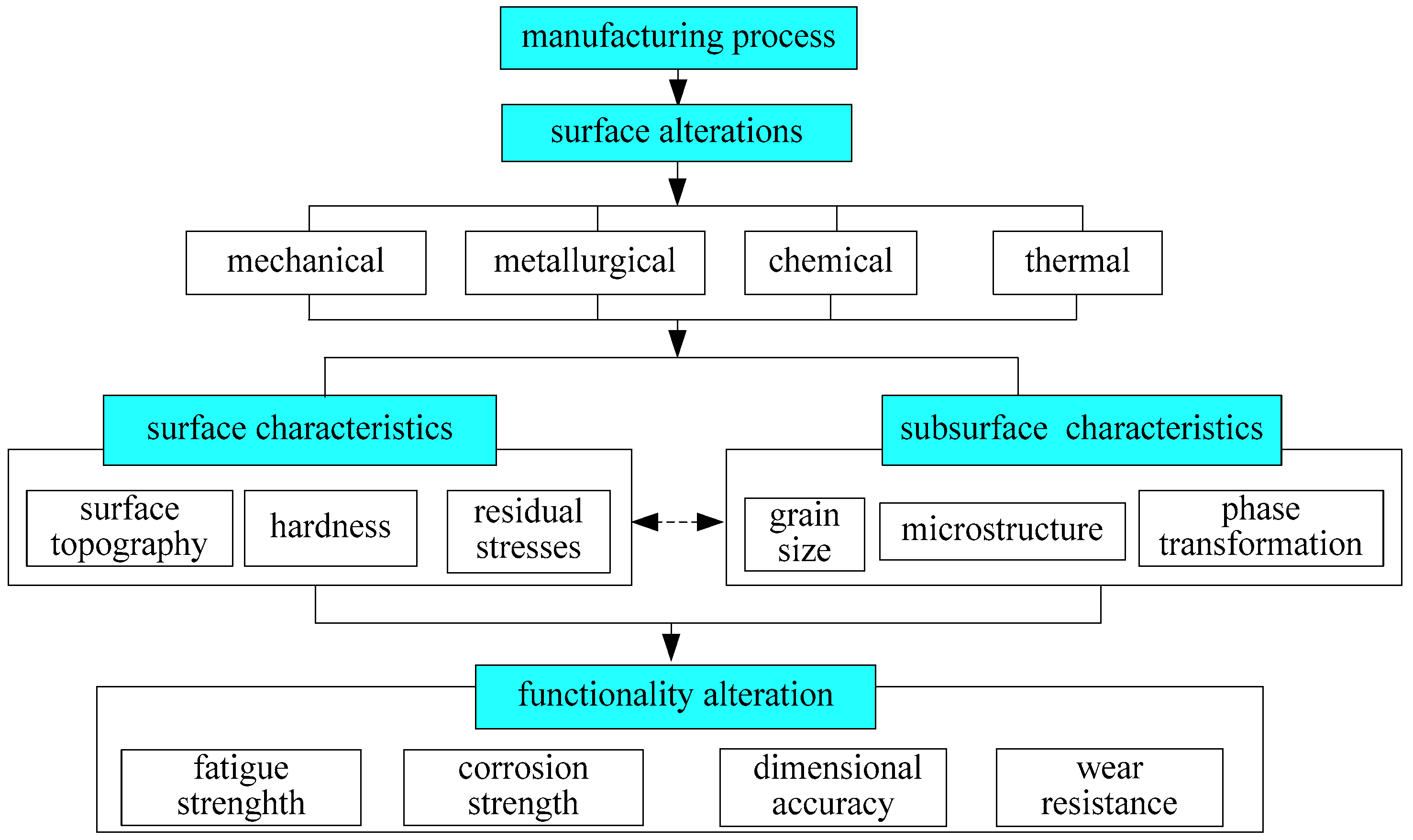
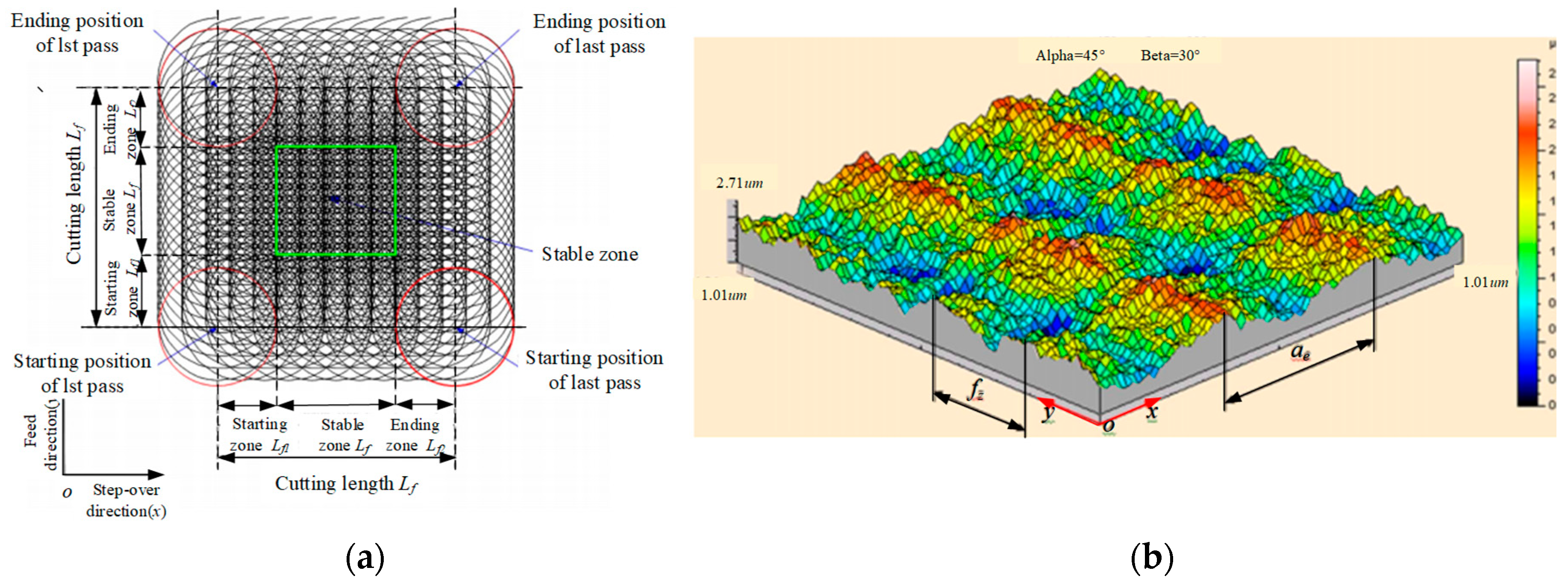


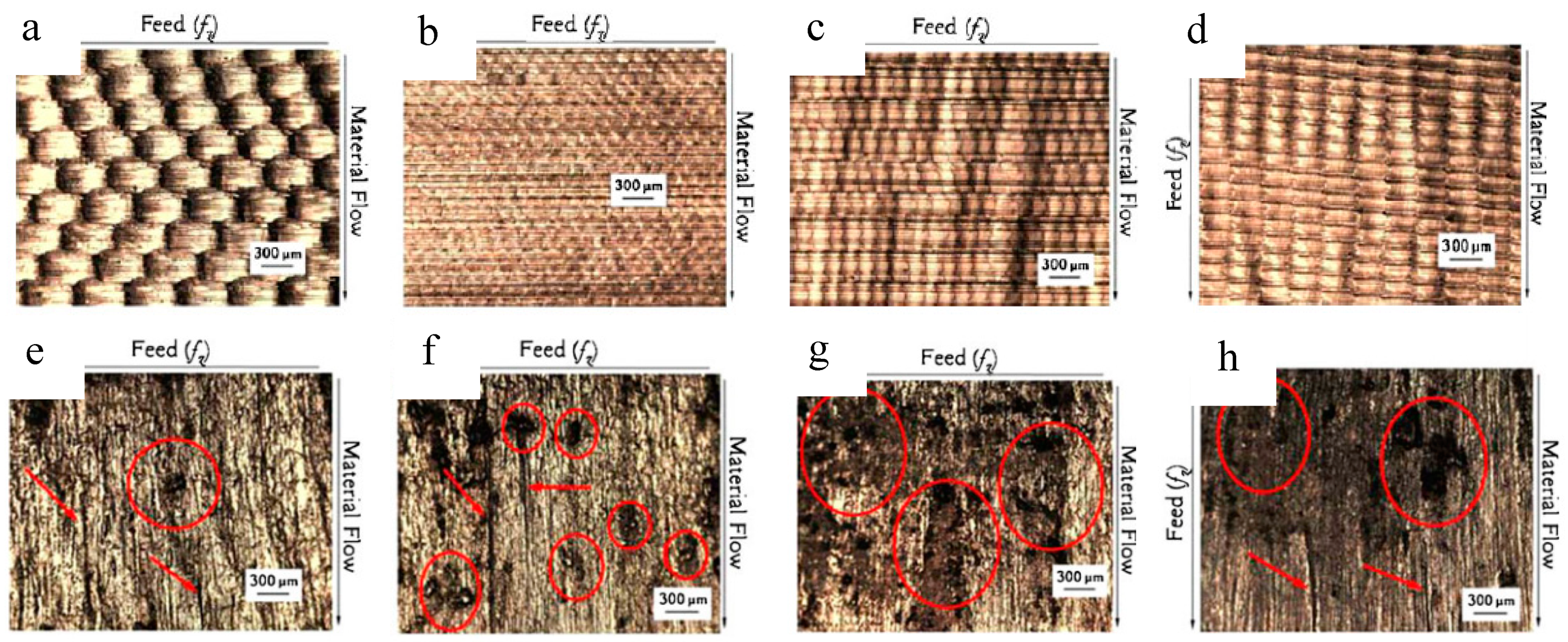
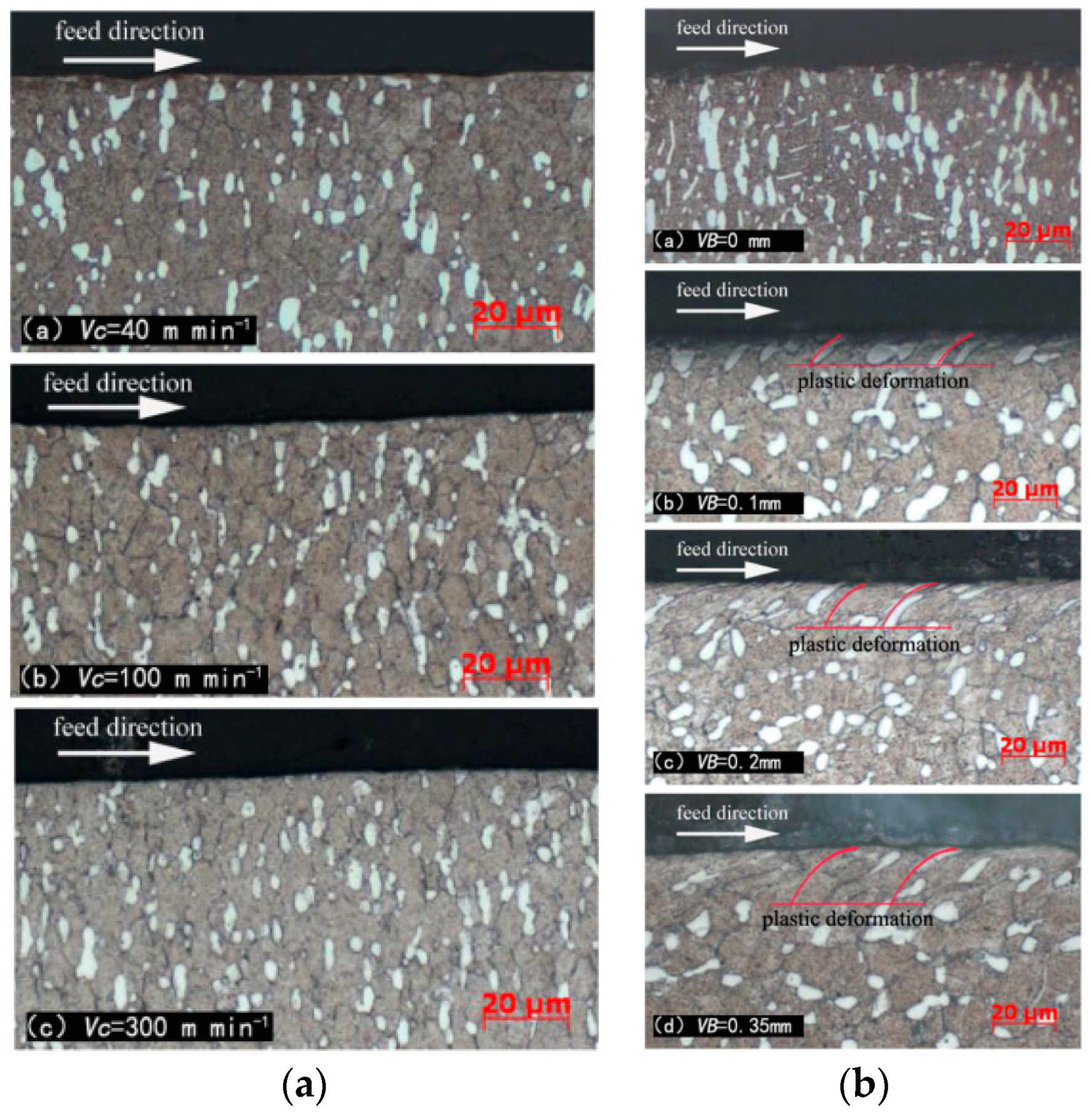

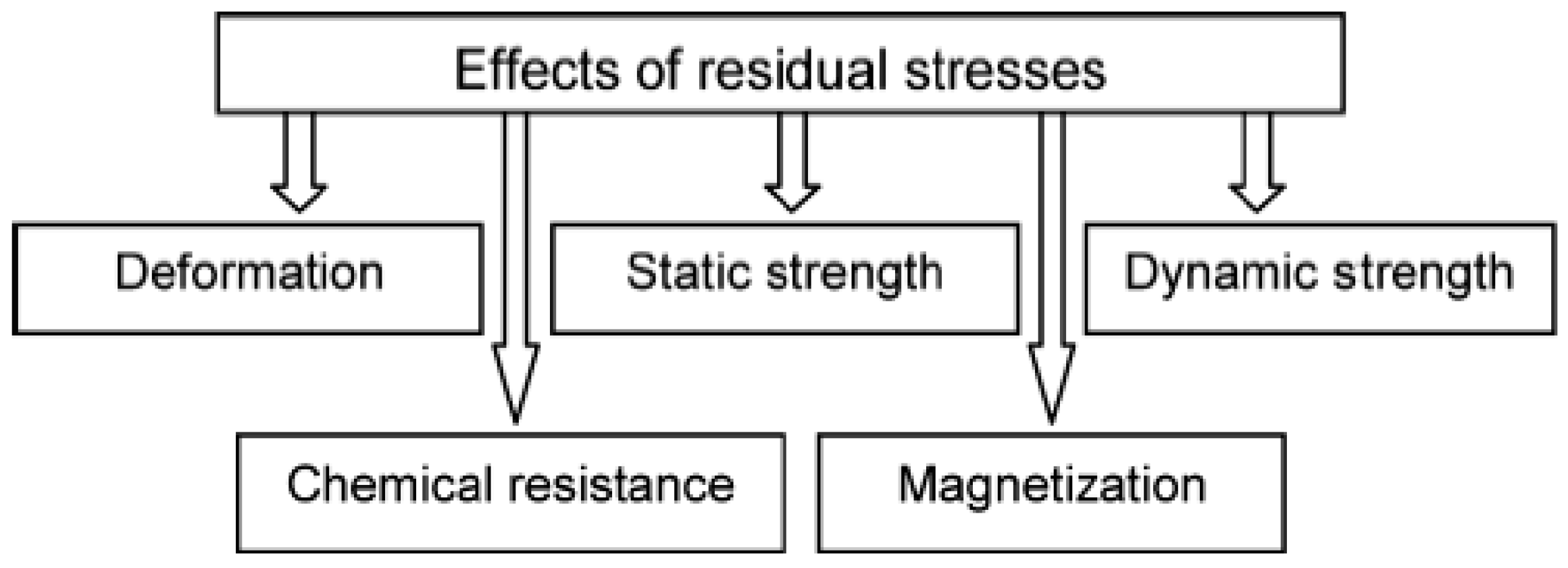
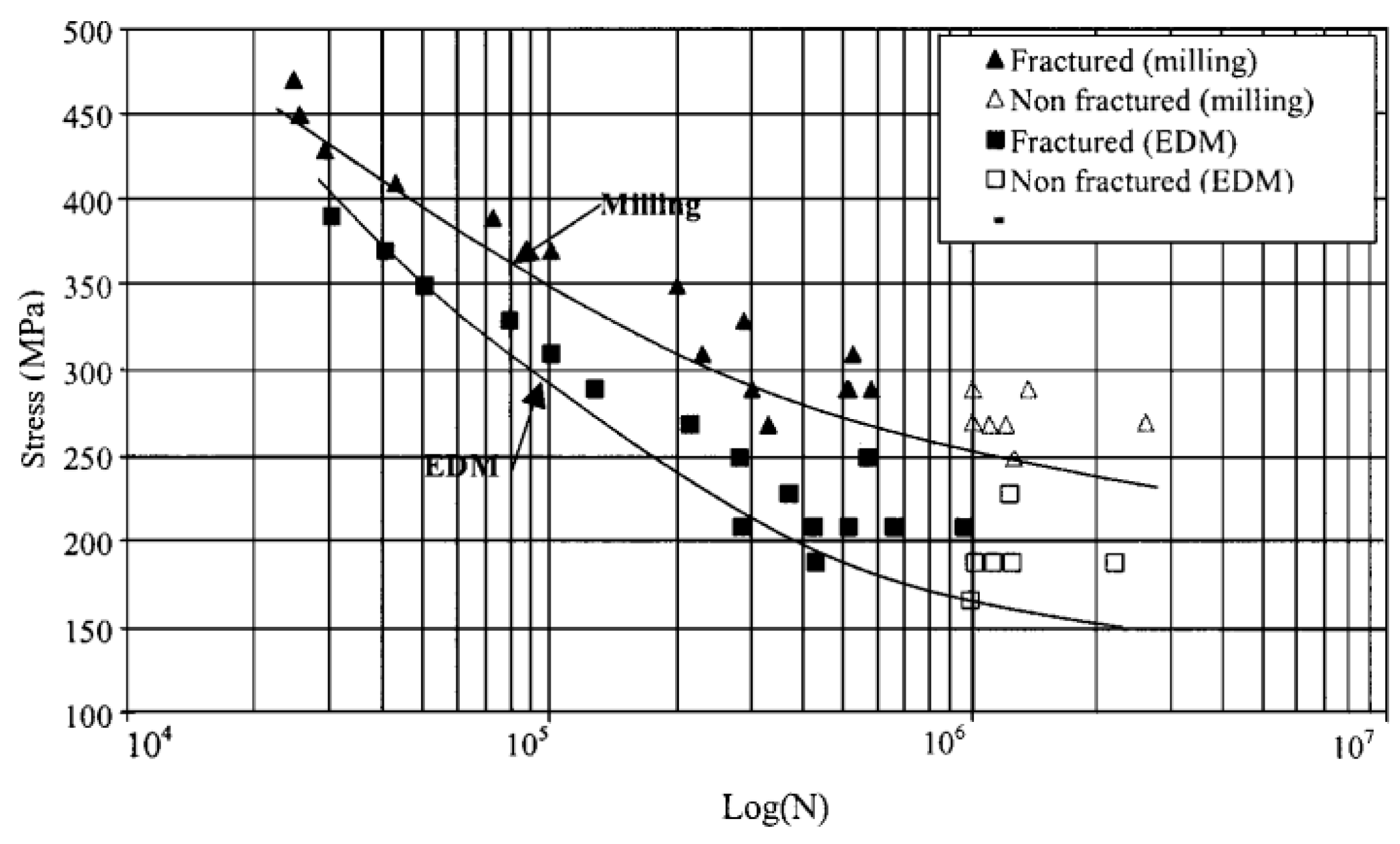
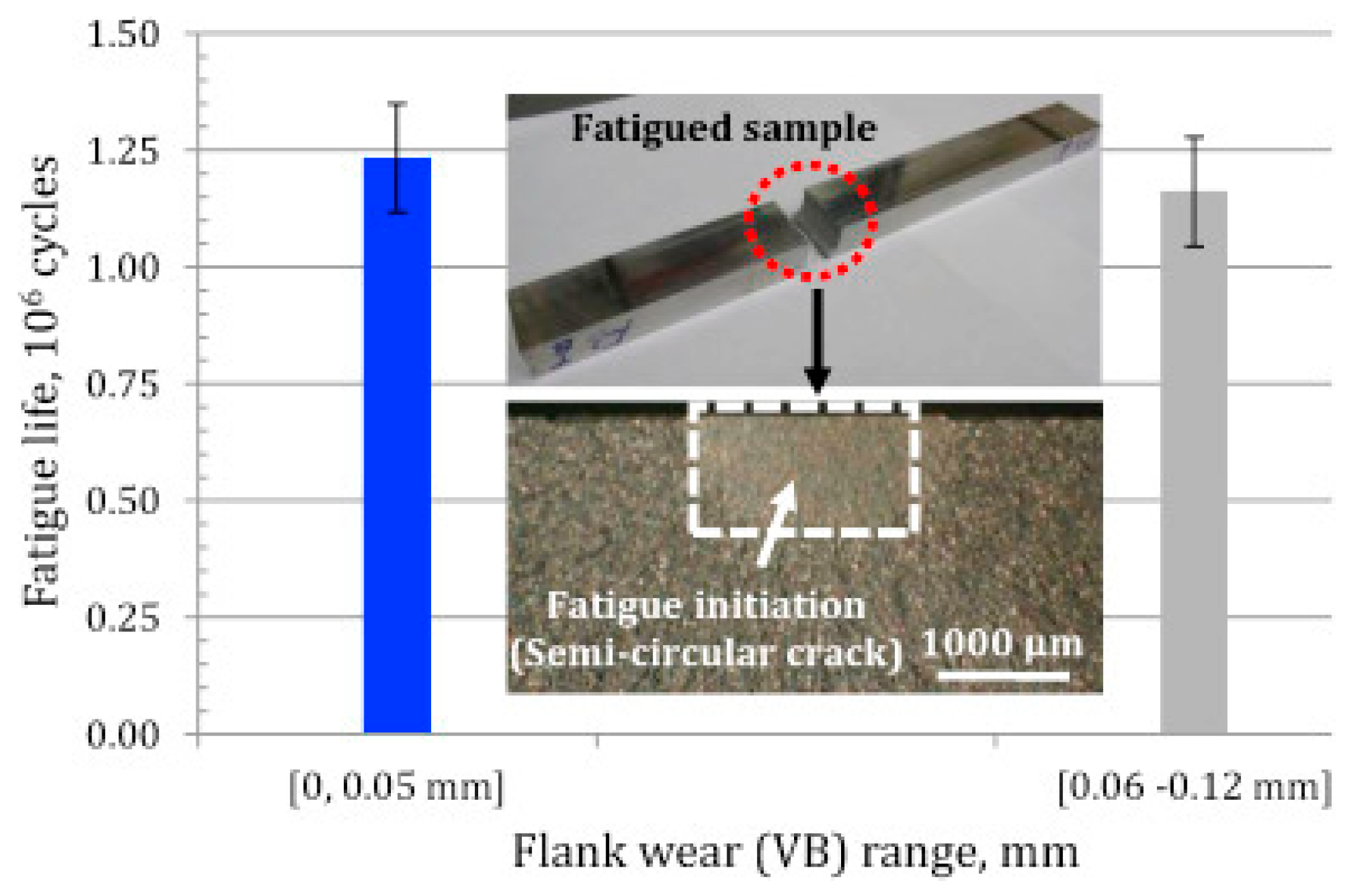
© 2018 by the authors. Licensee MDPI, Basel, Switzerland. This article is an open access article distributed under the terms and conditions of the Creative Commons Attribution (CC BY) license (http://creativecommons.org/licenses/by/4.0/).
Share and Cite
Yue, C.; Gao, H.; Liu, X.; Liang, S.Y. Part Functionality Alterations Induced by Changes of Surface Integrity in Metal Milling Process: A Review. Appl. Sci. 2018, 8, 2550. https://doi.org/10.3390/app8122550
Yue C, Gao H, Liu X, Liang SY. Part Functionality Alterations Induced by Changes of Surface Integrity in Metal Milling Process: A Review. Applied Sciences. 2018; 8(12):2550. https://doi.org/10.3390/app8122550
Chicago/Turabian StyleYue, Caixu, Haining Gao, Xianli Liu, and Steven Y. Liang. 2018. "Part Functionality Alterations Induced by Changes of Surface Integrity in Metal Milling Process: A Review" Applied Sciences 8, no. 12: 2550. https://doi.org/10.3390/app8122550
APA StyleYue, C., Gao, H., Liu, X., & Liang, S. Y. (2018). Part Functionality Alterations Induced by Changes of Surface Integrity in Metal Milling Process: A Review. Applied Sciences, 8(12), 2550. https://doi.org/10.3390/app8122550





